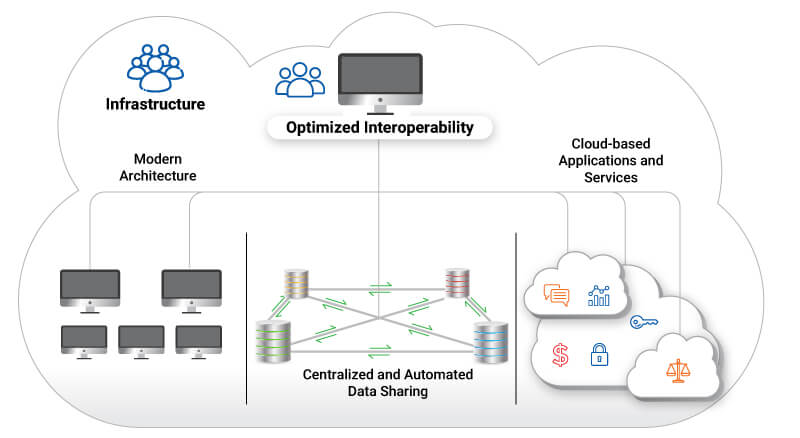Introduction
Trends show that financial service enterprises are increasingly opting for multiple cloud providers as the big players are dominating the public cloud services market. In a recent Gartner survey of public cloud users, 81% of respondents said they are working with two or more providers. Whether it is working with the public cloud providers, or more typically in a hybrid cloud model, a blend of private and multiple cloud providers is centered around nimbleness and speed of conveying change – whether as a FinTech with no legacy, or an incumbent firm. However, whilst most financial services firms have adopted some form of hybrid cloud, the focus is now turning to multi-cloud.
While cloud now has turned into a game changer for financial services owing to changing customer expectations and the shifting landscape, multi-cloud reassures its capabilities and gives a competitive advantage over typical infrastructures which is susceptible to failure.
What is Multi-cloud Data Management?
Multi-cloud approach is a strategy where organizations leverage multiple cloud computing platforms to perform various tasks. The dependency on a single cloud vendor can be avoided for the organizations where they can choose to use resources from various providers to get the best suited benefits from each unique service.
A multi-cloud solution might include distribution of cloud assets, varied software, applications, and more. It can be a model where Software as a Service (SaaS), Platform as a Service (PaaS), and Infrastructure as a Service (IaaS) are combined for the use of more than one private cloud and public cloud solutions.
What’s Driving Cloud Adoption in Financial Services
The reason for choosing multi-cloud strategies are different for different organizations. Some organizations want to avoid the dependency on a single cloud provider, as a multiple approach will further reduce financial risks while staying within the established data governance and data security controls. Getting tied up to a single vendor could be a difficult situation for an organization to adopt a responsive strategy.
Here are some factors that accelerates the drive for multi-cloud adoption-
- Better Return on Investment – Option for stakeholders to pick and choose the specific solutions that work best for their organization.
- Freedom of Choice – A single cloud provider may not be able to cater to all of the computing services it requires, whereas the choice of service providers allows flexibility.
- Containerization – Containers isolate applications and related libraries even when it has a pooled approach providing effective use of resources.
- Reduced Time to Market – Software-defined networking (SDN) and network function virtualization (NVF) simplifies configuration management for multi-cloud imparting market agility for financial organizations.
- Highly Reliable Architecture – Multiple cloud solutions reduce the risk of a single point of failure as it creates redundancies to depend on.
- Better Disaster Recovery – The outages or downtimes of multiple cloud vendors at the same time is unlikely and it also improves business continuity.
- Provider-specific Services – Organizations can choose from different cloud providers to best-fit specific applications and infrastructure requirements to their own unique business needs.
- Enhanced Scalability – An enterprise can quickly scale to multiple cloud providers as demand increases.
- Reduced Latency – Dispersed organizations can reduce latency by choosing local public cloud vendors based on each facility location.
- Reduced Footprint and Lower Costs – Avoids the need to build and maintain their own datacenter and in turn build a virtual data center in the cloud.
Challenges of Multi-cloud
- Growing cloud costs: Deploying and signing up to the increasing number of cloud apps/ service providers can result in an uptick in spending.
- Rapid changes in arrangements: Organizations run the risk of losing control of their identity processes, access management, and security.
- Specialist management expertise: Multi-cloud management requires specific expertise to ensure that an organization’s IT environment remains highly available and secure to avoid increased costs and complexity.
- Legacy security concerns: Businesses need to assess their networks, environments, and security architectures before implementing multi-cloud to avoid potential risks and liabilities.
- Data privacy and protection: Organizations need to provide seamless access to all their cloud services, maintain least privilege access across their cloud environments, and establish a robust identity architecture that federates with any application or service.
Current state of financial services infrastructure hampering operational efficiency

Optimized infrastructure supporting modern financial services

Multi-cloud for Financial Services Data Management
Modern data management solution should be compatible for multi-cloud integration as it increases the agility, flexibility and efficiency of financial services providers while meeting security and compliance needs. It also gives them real-time access to the cloud anytime without failure. The solution should be supporting all major cloud platforms such as AWS, Microsoft Azure, Google cloud, Snowflake, etc. to benefit from multiple cloud vendors. Extensible APIs, Interoperability, Cybersecurity and Compliance Management are the other architecture concerns. Also, it should support flexible storage which segregates and keeps different databases in separate platforms that can factor in other factors of focus like cost savings and operational efficiency. This could mean that reference data such as security master or price master can be on a cloud and investment data can be on another cloud platform in an integrated manner.
Amaze® for Capital Markets
Hexaware’s Amaze® for capital markets is a low-code no-code data management platform compatible with multi-cloud. A financial services cloud solution, it helps solve the problems associated with legacy solutions and generates insights to customers for better visibility and to accelerate business innovation. Amaze®’s in-built API orchestration for multi cloud strategy helps business users to switch cloud platforms when they consume data or view dashboards according to their need. It’s rich business glossary providing business definition for each capital market domain along with data lineage offers easy data governance and compliance management. Amaze®’s flexibility to integrate multiple cloud platforms from leading cloud vendors aid financial organizations with business agility and operational efficiency.



















